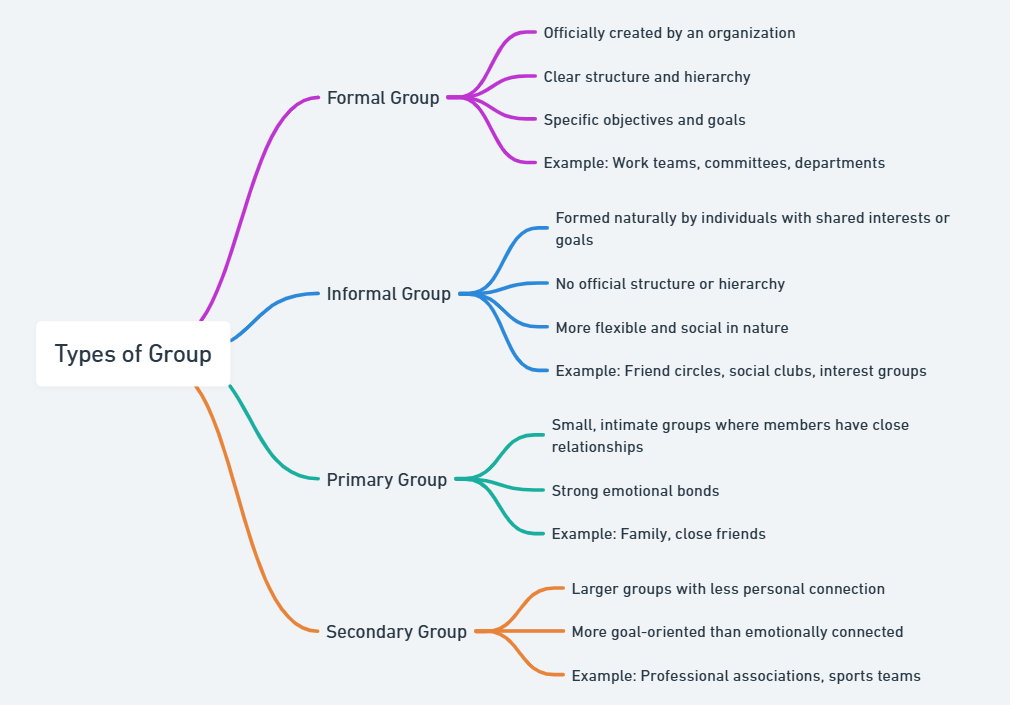Groups play the most important role in society today. They play significant roles in personal, professional, and academic life. Group dynamics are shaped by certain group features. How the group functions or reacts is determined by those specific features. It describes how a group should look but also sets the course of its success or failure. It can be an element to help individuals or institutions design better groups or well-coordinated groups. In this article, we will explore the characteristic features of a group-what it means, its significant characteristics, its types, and the development stages that occur in a group. Besides, we will discuss what can ensure the success of a group by setting a proper goal.
Meaning of Group
A group is a collection of people who come together with a common purpose. The members are those people sharing common interests, interact with one another regularly, and, usually, work toward the same goal. The word “group” can refer to any setting: social, academic, or professional. There can be formal groups like teams in organizations, but also informal groups, like when friends get together to watch a movie. The characteristic that defines the group is the interaction between people. Intentional or unintentional, these interactions impact the dynamics of the group and its effectiveness.
A group is not a matter of several people in the same space at the same time but about shared communication, interdependence, and joint effort toward achieving a certain goal. Although the number of members can vary, the crucial element is the relationships established among them. These relationships define the group structure and culture. In this manner, a group also goes beyond the actual physical presence of the group members to the psychological and emotional bonds that join them together.
Main Features of a Group
The main features of a group are what make the difference between a group and just a collection of people. These features serve as a basis for the function of group behavior, governing the way members relate to one another and the group’s overall performance. A group’s primary features are the number of members, influence, goals, norms, structure, and interaction. Let’s elaborate on each of these.
Number of Members
A group normally consists of at least two people, but the size of the group varies considerably depending on the objective of forming the group. A small group, commonly referred to as a team, would have anywhere from 3 to 10 members while a large group may contain dozens or hundreds. The number of members affects how well communication flows, how decisions are made, and how much influence any single individual has on the group.
In smaller groups, the members tend to have a lot of personal contact and influence over the direction that the group will take. However, when the group size increases, it becomes more difficult to maintain close relationships and personal influence. More formal structures and processes tend to be necessary in larger groups to manage the interactions and decision-making.
Influence
A group has the influence feature. A member can influence the behaviors, thoughts, or actions of others. Influence in a group is not necessarily determined by authority or position. It can come from expertise, charisma, or the ability to build trust and rapport. Influence can be positive or negative. Positive influence will motivate the group to attain the goals, whereas negative influences or presences create a kind of disturbance in group cohesion and effectiveness.
This then is the balance of influence in a group. Should one person dominate the power of the group, such can lead to power tugs of war or decisions that seem to be against the welfare of all members. Again, if there is insufficient group influence, it can result in confusion or poor directions of influence.
Goals
A group exists because of a common purpose. Their goals are the reason their group forms, directs and succeeds. The goals give members a reason for the existence of the group and, therefore, something to work toward. The clarity of their goals determines how well that group will work together as a team. Clear well-defined goals keep everyone from getting off track and ensure one’s efforts are aligned properly toward achieving the desired end.
Goals may be short-term or long-term, simple or complex, and in the context of business, the goal for a group may be to finish a project by a specific date, whereas, in the social setup, it could be the maintenance of good friendships or the promotion of causes in society. How a group measures success and keeps track of its progress also determines how it sets goals.
Norms
The unwritten rules and expectations regarding how members of a group should behave are known as norms. The norms include the way the people relate to each other, in communicating, in making decisions, and in the way the members treat one another. Norms can emerge with time or at the very outset of formation.
Group norms often shape the culture of the group and affect everything from how people interact to how tasks are completed. For instance, a group may have a norm of punctuality in meetings or a norm of encouraging open discussion. These norms help regulate behavior and ensure consistency in how the group operates.
Structure
The nature of every group’s makeup is referred to as their structure. It depicts a way in which members have been organized and power assigned and responsibilities. A formal group, like organizations, teams, etcetera, usually has a definite line of structure in its framework. For example, where a manager is placed supervising employees, the workers also have specific roles in turn.
In informal groups, the structure may not be very rigid. Roles in informal groups may be more fluid, based on the members’ strengths, interests, or availability. The group’s structure is important to make sure work is evenly distributed and that clarity exists about who is doing what.
Interaction
The most fundamental characteristic of a group is the interaction between its members. It is the interaction that allows the group members to communicate, share ideas, decide on matters, and work together to solve problems. This is the glue that binds a group together. With regular interaction, the people develop relationships, grow in trust, and also build up their sense of belongingness within the group.
Interaction can come in a variety of ways, including face-to-face, virtual meetings, phone calls, or group chats. The nature of interaction depends on the size and purpose of the group. For example, in a small group, interaction may be more personal and informal. However, in a large group, interaction can be more structured and task-oriented. Effective interaction is critical for maintaining cohesion and ensuring that everyone is engaged in the group’s activities.

Types of Groups
Groups come in all shapes and sizes, and each comes with different characteristics, functions, and interrelations. Knowing the types of groups helps in knowing how to approach them, set goals, and manage interactions accordingly. Generally, there are two broad types of groups: formal groups and informal groups.
Formal Groups
Formal groups have a defined structure and form with roles, rules, and objectives. These are groups that are formed for specific tasks or goals to be accomplished. Their formation is usually defined by an organization or institution. Examples include project teams, committees, workgroups, and task forces. Formal groups usually hold set meetings, defined roles, and an established hierarchy that defines their operation. They are normally governed by rules or policies that define the way tasks should be accomplished.
A formal group’s success very much depends on how the structure of the group will fit the goals of that group. Formal groups require clear communication channels, defined responsibilities, and good leadership to maintain focus and achieve goals.
Informal Groups
Informal groups are spontaneous and not governed by any kind of formal structure or organization. They mostly develop from common interests, shared experiences, or personal relationships. Examples of informal groups are friends, social clubs, or interest-based groups within an organization. Informal groups are less structured than formal groups and do not have any official rules or regulations to follow.
Informal groups are usually relatively fluid in their dynamics. They provide a sense of belonging and support that may be absent in formal groups but without clear objectives or strong leadership, informal groups do not have direction or perhaps even focus.
Formation of Group Development and its Stages
Different stages of growth and development in groups characterize every group in their progression. Understanding all these phases helps group members and leaders manage the group’s dynamics and guide them toward success. The stage of group development is characterized by five different phases known as forming, storming, norming, performing, and adjourning phases.
Forming
The forming stage marks the first time the group is coming together. Members meet one another and receive some sort of initial orientation, at which point they begin to learn about each other. The forming stage is often characterized by ambiguity because members will not feel secure or assured of their positions in the group. The communication often remains polite and superficial due to the learning of everyone’s place within the group.
During this phase, the goals and norms for the group are not clear; hence the group lacks a sense of direction. A guiding leader can assist during this phase, especially in making clear expectations to the group in terms of the direction and what they can do to make their group functional.
Storming
This is a conflict and disagreement stage characterized by storming. When members of the group feel more comfortable with each other, they tend to share differences in opinion, preferences, and approaches. It’s a tension-filled phase of competition, where there will be disagreements over roles, responsibilities, and strategies.
This stage is challenging, but it is an important part of group development. Leaders should facilitate open communication, mediate conflicts, and help the group find ways to resolve differences constructively. Once this stage is passed, the group can start to solidify its goals and approach.
Norming
In the norming stage, the group starts establishing its norms, roles, and responsibilities. Members have largely solved their conflicts and now start working more collaboratively. A sense of cohesion emerges as individuals begin to understand and respect one another’s strengths and weaknesses.
Group members are more comfortable within the roles and responsibilities. There is a clear articulation of the group goals and their commitment to achieving them; effective communication and cooperation prevail within the group as their identity is consolidated.
Performing
The performing stage is the point when the group reaches its maximum potential. At this point, the group is at a productive and effective level. There is confidence among the members in their respective roles. Communication is open and effective. The group works seamlessly, taking up complex assignments and accomplishing its tasks.
At this stage, the group is well-coordinated, and there is a strong sense of unity. The leader’s role usually changes from directing to facilitating and supporting the group’s progress.
Adjourning
The adjourning stage is when the group has achieved its goals and is disbanding. This stage is emotional since members are reflecting on their experiences and achievements. The leaders ensure that the achievements of the group are recognized, and the way of transition is done with positive relationships.
How You Can Set Goals for Groups
The setting of goals is the success of any group. Well-defined goals give direction, focus, and motivation to the members of the group. A group without well-defined goals may lack direction and therefore may not be able to achieve meaningful results.
Understanding the SMART Framework
One of the most popular methods for setting goals is the SMART framework, which stands for Specific, Measurable, Achievable, Relevant, and Time-bound. If group members meet all these criteria, they will be able to stay focused and motivated.
- Specific: The goal should be clear and precise, leaving no room for ambiguity.
- Measurable: There should be clear criteria for measuring progress.
- Achievable: The goal should be realistic and attainable.
- Relevant: The goal must align with the group’s overall purpose and objectives.
- Time-bound: Set a specific timeframe for completing the goal.
Goal Setting and Communication
Communication is key to achieving goals in a group. Each member must be involved in the setting of goals so that there are no misunderstandings between any of the members. Conduct periodic meetings to discuss progress, overcome challenges, and share accomplishments.
Features of a Group FAQs
What are the primary features of a group?
The primary features of a group include the number of members, influence, goals, norms, structure, and interaction. These elements guide the behavior of members and define the overall functioning of the group.
How do you develop group norms?
Group norms develop naturally over time as members interact. However, clear communication and shared experiences help establish expectations and acceptable behaviors.
What are the stages of group development?
Groups typically go through five stages of development: forming, storming, norming, performing, and adjourning. These stages help groups evolve from initial uncertainty to effective collaboration.
How do you set goals for a group?
Setting goals for a group involves using the SMART framework: Specific, Measurable, Achievable, Relevant, and Time-bound. Engaging all members in the goal-setting process helps ensure alignment and commitment.
What types of groups exist?
Groups can be categorized into formal groups, which are structured with specific roles and objectives, and informal groups. People naturally form them based on shared interests or relationships.

